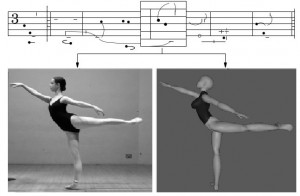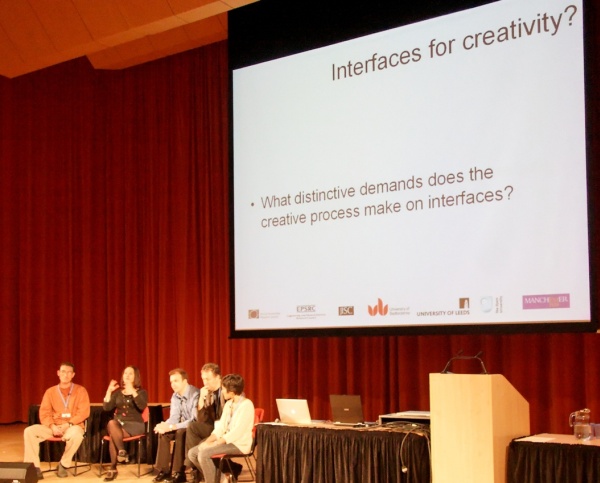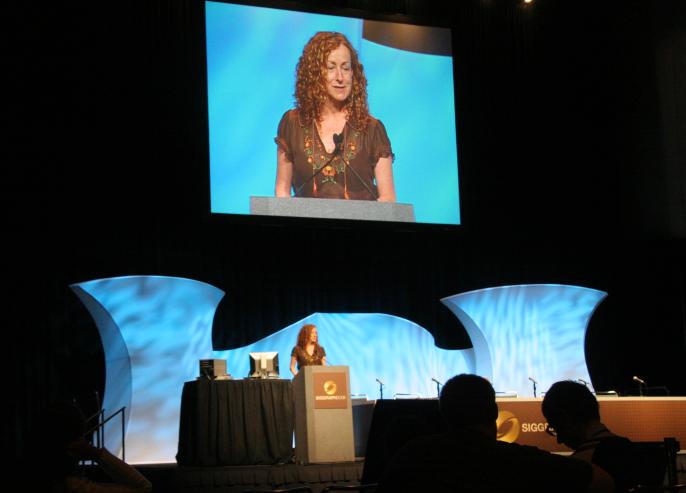8
12
2009
Helen Bailey gave the opening keynote at UK e-Science All Hands Meeting: “Assessing the impact of e-Science technologies on practice-led research in dance through the e-Dance project”
I don’t need to do any more than point to other blogs 🙂
http://gridtalk-project.blogspot.com/2009/12/e-thereal-dancing.html
Comments : No Comments »
Categories : Uncategorized
6
09
2009
I was reminded of a paper from a few years ago visualizing Benesh notation for ballet, via VR (avatar 3D geometry models) the following image is a “pose annotating using Benesh notation of an arabesque posed by a real dancer and virtual ballet dancer”

Reference “Neagle, R. J., Ng, K., & Ruddle, R. A. (2004). Developing a virtual ballet dancer to visualise choreography. Proceedings of the AISB 2004 Symposium on Language, Speech and Gesture for Expressive Characters, 86-97. Leeds, UK: Society for the Study of Artificial Intelligence and the Simulation of Behaviour. ISBN 1 902956 39 0.”
Comments : No Comments »
Categories : Uncategorized
24
08
2009
Since 2000 there has been analysis of a piece by William Forsythe “One Flat Thing:Reproduced”. This has been, as well as a large piece of content, a labour of love and extreme hard work – lots appears to be hand created (segmentation, registration etc) and then specific areas selected for specific contect/story.
This was running at the Aesthetics Area of SIGGRAPH in 2009 without anyone present to explain. Check out the SynchronousObjects site that describes effectively 16 different ways to look at the work.

Comments : No Comments »
Categories : Uncategorized
23
09
2008
The presentation consisted of a related group of projects under the theme of interfaces; sort of sub title ‘where is the interface’. A sub-context was on tool building and their use. There were a few comments and questions during and after the set of presentations.
- Couple of questions considered the use of ‘visualization’ tools that could be used in the creative process, and creating new processes. This was an area of obvious exploitation.
- An issue was the new choreographic modes developed.
- Also interest was raised in new annotation methods – and what an interface for practical purpose may be needed.
- A comment asked what was new with this mix of telepresence; and an important emphasis needs to be the research benefits that choreography gains from ‘pushing e-science to the limits, as well as importantly the reverse that is the benefits HCI and the e-science communitybenefits from the project. Onecurrent benefit for e-science has been thinking of interface design without being encumbored by the ususl Apple/MS Windows philosophies.
- Tool reuse – how much customisation should there be and if we are suporting the right tool base. There is a continual debate over which tools to use and if it is easier to develop or search for other tools already there with similar features to those required.

Comments : No Comments »
Categories : Uncategorized
18
09
2008
      
We all managed to get together for one day during DRHA 2008, University of Cambridge, UK, 14-17 September http://www.rsd.cam.ac.uk/drha08/ . It was great to have the chance to catch up after a summer of really interesting activity on the project. Sita, Martin, Simon and myself (together with Scott Palmer from University of Leeds) were all participating in a panel that we had proposed for the conference. We presented three projects Stereobodies/Choreographic Morphologies (Martin and I) http://kato.mvc.mcc.ac.uk/rss-wiki/SAGE/StereoBodies , Projecting Performance (Sita and Scott) http://www.leeds.ac.uk/paci/projectingperformance/home.html and e-Dance (Simon and I). The focus of the panel that brought the three projects together, was concerned with the role/function/construction of ‘interfaces’ in dance.  The panel abstract summarised the dicussion as follows;Â
“This panel will discuss visual communication interfaces in dance performance environments through the frames of three current/recent projects. These projects use digital technologies to facilitate non-co-located performances, either between dancers at different sites or between on-stage dancers and off-stage operators. The three projects offer intersecting yet distinct perspectives on this process. The panel will question how such interfaces are experienced by th performers, how they can be approached as choreographic environments, and how they affect the rpocess of viewing. In an art form that prioritises physicality and embodied knowledge, how do dancers negotiate their performances with remote partners via digital interfaces? how might such interfaces redefine choreographic understandings of embodied spatio-temporal relationships? How might spectators engage differently with performances that exist in their entirety only at the boundary of the digital interface?”
This set of presentations, together with All Hands last week served as a really good opportunity for reflection at the half way point in the project. We also had the chance to have some good discussions about where we are heading. The next ‘Project Sandpit’ will take place on 9-10 October in Manchester. So that will give us the space to map out the next few months activity and chart the direction for developments with Compendium/Cohere.
Comments : 1 Comment »
Categories : Dissemination, Event, Team, Theory, Uncategorized
26
08
2008
SIGGRAPPH (ACM Special Interest Group in Graphics, http://www.siggraph.org/) has been a long running and very large conference aimed mostly at the technical aspects of Computer Graphics: Games industry, Hollywood, animation productions are all beneficiaries of the outcomes from these research topics. The University of Manchester runs a Professional Chapter of the organisation and was at the meeting (LA August 2008) to promote activities (http://manchester.siggraph.org/).

This year there was an arts orientated keynote Catherine Owens (Artist/Director CO-DIRECTOR, “U2 3Dâ€) Giving Technology Emotion: From the Artist’s Mind to “U2 3Dâ€. She discussed the aspects of creating a 3D movie from U2’s tour of South America. Catherine has been working with U2 for many years, and the move to 3D was adventurous – using multiple 3D camera setups from famous sources. Time and development were key – the post editing took 18 months and new 3D blends were specially developed to allow different 3D scenes to blend together; as well as the use of a multiple sets of expensive 3D cameras.
A quote was 3D should be “easy on the mind”. So there were very few “obvious” 3D effects and more story telling: although quiet a few 3D overlay and blending effects; compare with transparency and overlay requirements. Link to the official site: http://www.u23dmovie.com/
“Irish artist/director Catherine Owens creates installations that evolve through painting, sculpture, photography, sound, and video. She is well known for her collaboration with the Irish band U2 on their last four world tours. She co-directed “U2 3D,†a documentary of the band’s live performance in South America on their 2006 Vertigo tour. “U2 3D†is the first live-action feature-length 3D digital theatrical release…”
Throughout the meeting projected 3D presentation was a focus, and the screening of U2 3D being a key point. This also demonstrated that mix between arts and science is also blending. This work is an example of a much larger and (obviously) commercial exploitation of similar e-Dance type outcomes and interesting to compare.
Comments : 1 Comment »
Categories : Uncategorized
24
04
2008
The software requirements for the first research intensive were local recording and playback plus any developments from the ‘wish list’ which we would manage till than. That is what we provided:
- audio transmission; previous code just supported the receiving of audio
- local recorder and playback; recording of all local and received video and audio streams
- support of fire-wire camcorders
- option to remove window frames from video windows
- transparency of windows; current method does not work with video windows on top of video windows
- Soft- edged windows; same restriction as above, but nice without the window frame on a background
- for playback a time line set in minutes from the beginning – can be used to jump around in a recording
In the end we were traveling with all required equipment to Bedford and had to put in a number of last minute bug fixes during our time there. The final recordings on the last day we managed without a single software crash – we learnt what not to do 🙂
Comments : No Comments »
Categories : Uncategorized








